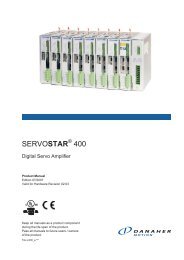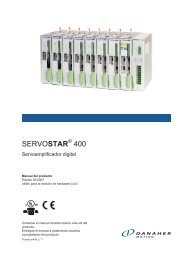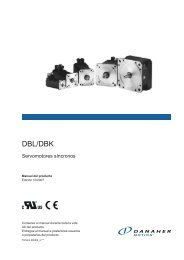SERVOSTAR™ 300
SERVOSTAR™ 300
SERVOSTAR™ 300
You also want an ePaper? Increase the reach of your titles
YUMPU automatically turns print PDFs into web optimized ePapers that Google loves.
Technical description 07/2010 Kollmorgen<br />
6.4 LED display<br />
A 3-character LED display indicates the status of the amplifier after switching on the 24V<br />
supply (� p.99). When the keys on the front panel are used, the parameter and function<br />
numbers are shown, as well as the numbers for any errors that may occur (� p.100).<br />
6.5 Grounding system<br />
AGND — analog inputs, internal analog ground, encoder emulation, RS232, CAN<br />
DGND — digital inputs/outputs and the 24V supply, optically isolated.<br />
6.6 Dynamic braking (brake circuit)<br />
During dynamic braking with the aid of the motor, energy is fed back into the servo amplifier.<br />
This regenerative energy is dissipated as heat in the brake resistor. The brake resistor<br />
is switched in by the brake circuit.<br />
The setup software can be used to adapt the brake circuit (thresholds) according to the<br />
electrical supply voltage.<br />
Our customer service can help you with the calculation of the brake power that is necessary<br />
for your system. A simple method is described in the "Product Wiki" which is accessible<br />
at www.wiki-kollmorgen.eu.<br />
A description of the interface can be found on page 59.<br />
Functional description:<br />
1.- Individual amplifiers, not coupled through the DC bus link circuit (DC+, DC-)<br />
When the energy fed back from the motor has an average or peak power that exceeds<br />
the preset level for the brake power rating, then the servo amplifier generates the warning<br />
“n02 brake power exceeded” and the brake circuit is switched off.<br />
The next internal check of the DC bus link voltage (after a few milliseconds) detects an<br />
overvoltage and the output stage is switched off, with the error message “Overvoltage<br />
F02” (� p.100).<br />
The BTB/RTO contact (terminals X3/2,3) will be opened at the same time (�p.82)<br />
2.- Several servo amplifiers coupled through the DC bus link (DC+, DC-)<br />
Using the built-in brake circuit, several amplifiers (even with different current ratings) can<br />
be operated off a common DC bus link, without requiring any additional measures.<br />
The combined (peak and continuous) power of all amplifiers is always available. The<br />
switch-off on overvoltage takes place as described under 1. (above) for the amplifier that<br />
has the lowest switch-off threshold (resulting from tolerances).<br />
Technical data of the brake circuits dependent on the amplifiers type and the mains voltage<br />
situation see table on the next page.<br />
28 SERVOSTAR <strong>300</strong> Instructions Manual









